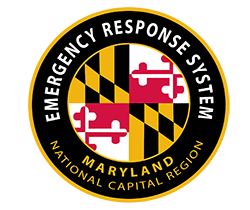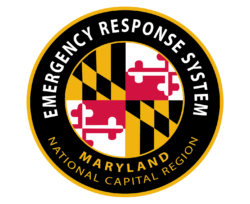The Maryland-National Capital Region Emergency Response System (MDERS) recently finalized their annual report for Fiscal Year 2020 (FY20). The period of performance for this cycle spanned from June 1, 2021, through May 31, 2022. During this period, the MDERS Fiscal Year 2020 – 2022 Strategic Plan served as a road map for carrying out the development and enhancement of capabilities through the execution of training and exercises. In FY20, MDERS in collaboration with stakeholder partners, continued its mission of developing and further enhancing response capabilities for law enforcement, fire/rescue/EMS, public health, emergency management, and the hospital systems in Montgomery and Prince George’s Counties. Those capabilities include:
Training and Exercise Program
- MDERS supported diverse training and exercise opportunities for stakeholders to collectively strengthen their response operations. MDERS sponsored 37 trainings for 565 total participants, planned and executed a Full-Scale Exercise (FSE) for Prince George’s County Police Department (PGPD) with 98 participants, planned and executed several tabletop exercises for Montgomery County Police Department (MCPD) and PGPD with 58 participants from MCPD and 23 participants from PGPD. These trainings and exercises have enhanced the MDERS stakeholder partners’ collective preparedness and response capabilities, thereby ensuring the safety and security of our first responders and the communities they serve.
Ballistic Protection for Fire, Rescue, and EMS
- MDERS assisted Prince George’s County Fire/EMS Department (PGFD) in outfitting their providers who are deployed into hot, warm, and cold zones with personal protective equipment (PPE). PGFD providers were equipped with ballistic body armor, vest-mounted medical supplies, ballistic eye and face protection, and ballistic plate carries.
Incident Command Tools
- MDERS focused on advancing the use of the incident command structure among Montgomery County Fire and Rescue (MCFRS), PGFD, and PGPD to minimize threats to public safety. For instance, MDERS supported the enhancement of incident command competency to better prepare frontline supervisors and command-level officers, building confidence in their decision-making. This was achieved through the development of static and dynamic immersive simulation training environments, acquisition of virtual reality (VR) tools, and the creation of command guidebooks. All PGPD command-level personnel were provided command guidebooks to serve as a resource when establishing command during an incident.
Emergency Management Support
- MDERS supported Prince George’s County Office of Homeland Security Emergency Management (PG OHS/EM) with their planning, training and exercise support program, response and recovery training program, and volunteer and donations management program. This funding strengthened various aspects of emergency management efforts, including community engagement, emergency preparedness, and medical training for personnel and civilians. Montgomery County Office of Emergency Management Homeland Security (MC OEMHS) also received funding for their emergency management support for planning, training, and exercise support, as well as volunteers and donations management. This funding supported increased preparedness training, a full-scale exercise for MC OEMHS’s Emergency Operations Center (EOC) and community engagement events.
Emerging Homeland Security Technology Pilot
To identify new opportunities for advanced response, MDERS allocated funding to evaluate and procure innovative equipment aimed at addressing evolving threats. During FY20, the acquired technologies and equipment helped enhance training for mass casualty triage, search and rescue, and situational awareness. First responders can sharpen their skill sets while implementing these innovations during response operations. The procured the technologies and equipment include:
- Augmented Training Systems (ATS) Virtual Reality Platforms: Allow responders to experience and train for a large flow of patients suffering from a diverse set of injuries.
- PerSim: Participants wear a headset that produces a 3-D holographic patient that is overlaid on a training manikin.
- Leader Search Bluetooth: Enable structural collapse teams to listen for trapped victims during a response.
- Vehicle Mounted Camera: Stream real-time footage of an incident scene back to the incident command post.
- Smartboard: Allow supervisors to use multiple platforms to monitor resource deployment and increase on-scene situational awareness.
- Manikins: Support in replicating an actual person during training events.
Mass Casualty Incident Supplies Transport Truck
- MDERS in partnership with Holy Cross Hospital System procured a Ford F-650 Super Duty Box Truck to expedite the retrieval and distribution of critical medical supplies during acute surge events in the Maryland-National Capital Region. This transport truck has enhanced accessibility, deployment, and storage of medical consumables for MDERS hospital stakeholders, thus improving regional healthcare response efforts.
Medical Resource Officer
- To bolster public health operations, MDERS continued to fund essential roles within Montgomery County Department of Health and Human Services (MC DHHS) and Prince George’s County Health Department (PGHD). The Medical Resource Officer (MRO) position provides logistical, medical, and other critical functions to support response efforts to public health crises. In FY20, the MRC for MC DHHS participated in community engagement activities and vaccination clinics to educate the public on the COVID-19 vaccines. The MRO for PGHD used their resources to furnish COVID-19 testing kits to the public and increase their volunteer operations to serve vulnerable community members from diverse backgrounds.
Public Access Trauma Care
- MDERS supported the Public Access Trauma Care (PATC) program with additional supplies to expand the capability within Montgomery and Prince George’s Counties. MDERS procured 85 training kits for Montgomery County Public Schools (MCPS), which include 15 tourniquets, 15 elastic bandages, 15 gauze bandages, 15 two-pack chest seal trainers, ten wound cube simulators, three emergency trauma dressings, cloth tape, quick litter, two emergency blankets, two shears, two-pack chest seals, two rolls of compressed gauze, two pairs of medical gloves, two sharpies markers, two mini duct tape rolls, and a sealed PATC kit.
Law Enforcement Special Events Response Cache
- In FY20, MDERS procured 85 special event personal protective equipment (PPE) kits for officers. The kits increase the safety of officers during deployments for active violence and/or public order incidents. Each kit contains full-body protective equipment, helmets, and ballistic shields. In addition to the kits, MDERS supported the participation of MCPD and PGPD in the Civil Disturbance Unit (CDU) Level 1 Training to ensure officers carry out appropriate response procedures and enhance their skillsets on maintaining public safety.
Tactical Equipment for Law Enforcement
- The tactical equipment for MCPD and PGPD included several types of innovative and advanced equipment. MCPD and PGPD received thermal monocular, night vision goggles, ballistic shields, ICOR Robots, Iris Robots, training supplies, ballistic plates, and tactical cold weather gear. During response operations, MCPD and PGPD use the tactical equipment to increase situational awareness and ensure officer safety.
Fiscal Year 2020 afforded MDERS, and its stakeholder partners the ability to further its mission of building and enhancing response capabilities within Montgomery and Prince George’s Counties. In the coming fiscal years, MDERS will continue to support its stakeholders and the communities they serve through planning, organizing, equipment acquisition, training and exercising. For more information about FY20 or any of the projects listed above, please contact MDERS by email at mders@maryland.gov.


